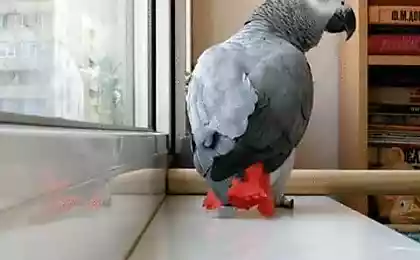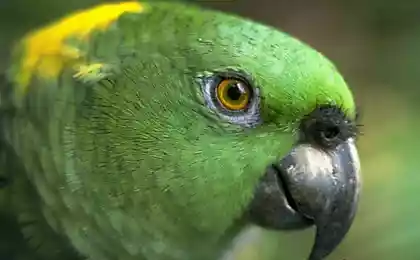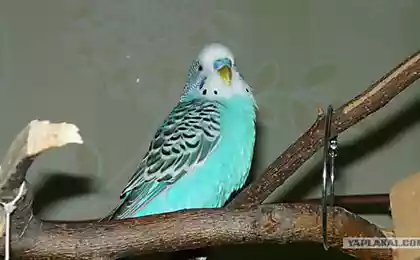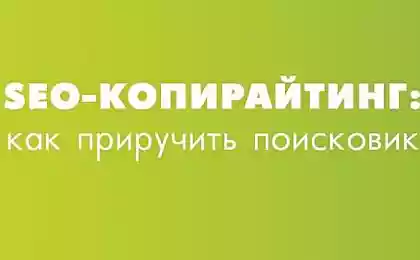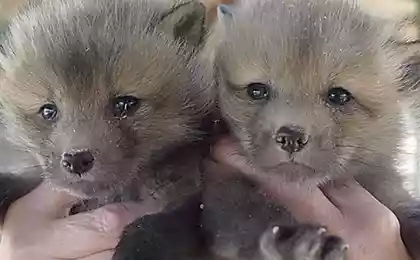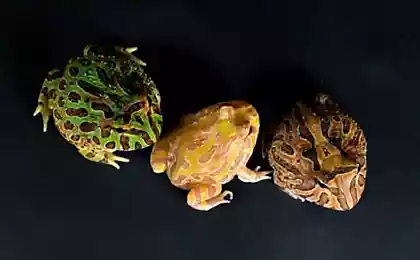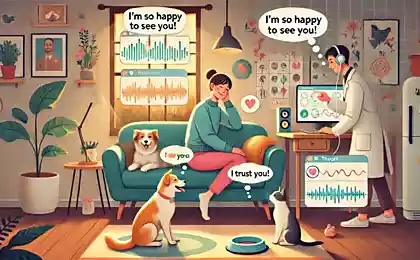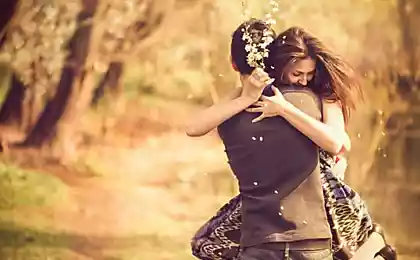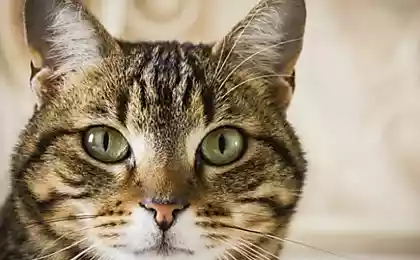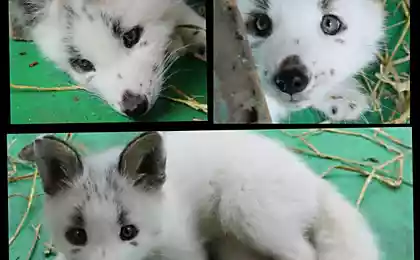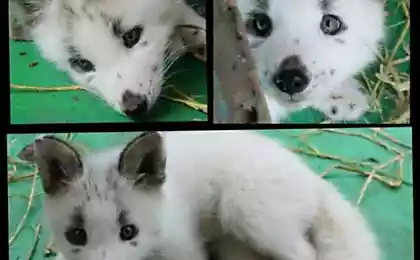462
How to train your parrot
In case of purchase of Chicks who have just left the box for nesting, it is likely to hide in a corner of the cell. The best for this period is to leave the bird alone. Maybe parrot will be afraid to approach the feeder, so a certain amount of grains it is necessary to scatter on the bottom of the cage.Ideally, approach the bird only when you need to change the water or to scoop food. At this time with the bird you need to talk calm gentle voice, as often as possible, calling her name. Such treatment should reassure feathered pet.The first day in the room where the cage is generally better not to go. After 2-3 days the family members one by one to enter this room. It is strictly forbidden to make noise, whistle, run, etc. Talk only in a quiet voice without much emotion. Window these days it is better not to open, a sharp noise from the street may scare the bird.After 5-7 days, you can cautiously begin taming. Thus it is necessary to carefully monitor the bird and upon the slightest manifestation of fear or anxiety it to stop. Novice breeders often complain that they can not understand in what mood their pet. It is easy to identify by its appearance.

Interest
If parrot something interested he starts to reach a head on this subject. It can slightly tilt the head in any direction. If you are interested in bird item toy, it may be a few times around her, to touch his beak or a little push.
Surprise
When a bird is startled, it begins to ruffle feathers and slightly lifts the feathers on the head. Sometimes he bows his head to the side or spreading his wings. The bird's eyes are wide open. If there is something unexpected and new for him, the parrot can jump aside and then, carefully, step by step approach to an unfamiliar subject.
Playfulness
In the game, especially if it is like the parrot, he tilts his head forward and starts from time to time to squint my eyes. If the object of attention
bird is the man, the parrot begins to gently bite his finger, flies up and sits on the shoulder, chirps, pushing him, etc., If the bird approaches the man and stops nearby, his eyes closed, so she wants to be caressed or paid attention to.

Waiting
Usually a long wait for something parrots don't have the patience.
All this time the bird expresses impatience – bounces up and down, tilts in different directions head, wide open eyes, sometimes fluffs feathers, etc. If the parrot did something new, he will wait for the human response to this action. It is important at this moment to properly respond, making it clear the bird was approved her act or not.
Excitation
About but is often observed during the preparation to the period of nesting. During courtship the female parrot fluffs its feathers and raises the feathers on his head. He gently leans to the female treats her tidbits, strutting around her and something whistling.
Aggression
There are times when something annoys the bird and he becomes aggressive. In such cases it eroset feathers, raises the feathers on his head, raises his head and opens his eyes widely. If seen this behavior Poppa ICH IKA, it is better not to approach it – he might even rush to their beloved master and bite him. Fear. If the parrot is afraid of something, he firmly attaches the feathers to the head, tips it back and the whole is compressed into a ball. However, he narrows his eyes and tries to hide somewhere.
Drowsiness. If the bird is overcome by drowsiness, he spent a long time sitting in one place, slightly raising one foot, and he shutteth (closes) eyes. Feathers located on the breast, slightly bristling.
Cold. When a bird is cold, it fluffs the feathers and sits hunched on his perch, his eyes wide open.Perhaps in the first days will be difficult to determine the mood of parrots, but over time you can easily learn to recognize the emotions experienced bird at the moment. To adapt to new conditions, the parrot will take some time. It needs to adapt not only to new people, but also to a new cage, toys and equipment. To help him, you need every time you walk past the cage, telling the bird something affectionate, usually called by name.Many parrots, especially in the first days of stay in a new place, don't like it when their cage is inclined. Birds of this very scared. To avoid this, at least for the first 1-3 weeks you need to put the cage higher up, preferably on a height of a man (on the fridge, Desk, wardrobe). Then, depending on the reaction of the parrot, the cage can be lowered down or leave in the same place.Parrot first 2 weeks it is better to feed frequently, such as every 3-4 hours Food you need to give a little. In this case, it is important not to feed and the contact in the process of feeding will be established between parrot and person.
First time parrot may refuse food, but the following products will fall exactly to his liking:
chopped boiled egg; porridge cooked from crushed cereals (porridge should be warm, about 37°C); white bread, soaked in milk or sweet tea; carrot juice; biscuits.
published
Source: /users/1092

Interest
If parrot something interested he starts to reach a head on this subject. It can slightly tilt the head in any direction. If you are interested in bird item toy, it may be a few times around her, to touch his beak or a little push.
Surprise
When a bird is startled, it begins to ruffle feathers and slightly lifts the feathers on the head. Sometimes he bows his head to the side or spreading his wings. The bird's eyes are wide open. If there is something unexpected and new for him, the parrot can jump aside and then, carefully, step by step approach to an unfamiliar subject.
Playfulness
In the game, especially if it is like the parrot, he tilts his head forward and starts from time to time to squint my eyes. If the object of attention
bird is the man, the parrot begins to gently bite his finger, flies up and sits on the shoulder, chirps, pushing him, etc., If the bird approaches the man and stops nearby, his eyes closed, so she wants to be caressed or paid attention to.

Waiting
Usually a long wait for something parrots don't have the patience.
All this time the bird expresses impatience – bounces up and down, tilts in different directions head, wide open eyes, sometimes fluffs feathers, etc. If the parrot did something new, he will wait for the human response to this action. It is important at this moment to properly respond, making it clear the bird was approved her act or not.
Excitation
About but is often observed during the preparation to the period of nesting. During courtship the female parrot fluffs its feathers and raises the feathers on his head. He gently leans to the female treats her tidbits, strutting around her and something whistling.
Aggression
There are times when something annoys the bird and he becomes aggressive. In such cases it eroset feathers, raises the feathers on his head, raises his head and opens his eyes widely. If seen this behavior Poppa ICH IKA, it is better not to approach it – he might even rush to their beloved master and bite him. Fear. If the parrot is afraid of something, he firmly attaches the feathers to the head, tips it back and the whole is compressed into a ball. However, he narrows his eyes and tries to hide somewhere.
Drowsiness. If the bird is overcome by drowsiness, he spent a long time sitting in one place, slightly raising one foot, and he shutteth (closes) eyes. Feathers located on the breast, slightly bristling.
Cold. When a bird is cold, it fluffs the feathers and sits hunched on his perch, his eyes wide open.Perhaps in the first days will be difficult to determine the mood of parrots, but over time you can easily learn to recognize the emotions experienced bird at the moment. To adapt to new conditions, the parrot will take some time. It needs to adapt not only to new people, but also to a new cage, toys and equipment. To help him, you need every time you walk past the cage, telling the bird something affectionate, usually called by name.Many parrots, especially in the first days of stay in a new place, don't like it when their cage is inclined. Birds of this very scared. To avoid this, at least for the first 1-3 weeks you need to put the cage higher up, preferably on a height of a man (on the fridge, Desk, wardrobe). Then, depending on the reaction of the parrot, the cage can be lowered down or leave in the same place.Parrot first 2 weeks it is better to feed frequently, such as every 3-4 hours Food you need to give a little. In this case, it is important not to feed and the contact in the process of feeding will be established between parrot and person.
First time parrot may refuse food, but the following products will fall exactly to his liking:
chopped boiled egg; porridge cooked from crushed cereals (porridge should be warm, about 37°C); white bread, soaked in milk or sweet tea; carrot juice; biscuits.
published
Source: /users/1092
